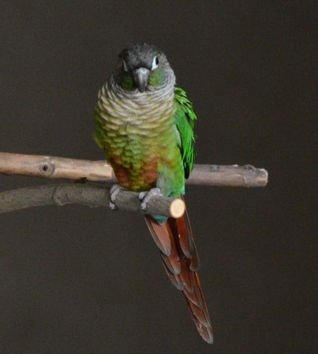
Our July edition of Animal of the Month shone the spotlight on the Green-cheeked conure. We tweeted about the Green-cheeked conure all month – and we almost expected these sassy little birds to tweet right back! Here is a summary of our tweets in case you missed them and be sure to follow us @ExoticPetVets so you can see who our next Animal of the Month will be. Did you know?:
- There are many conure species, but the Green-cheeked conure (Pyrrhura molinae) is among the most commonly kept as a pet.
- Green-cheeked conures are native to South America, where they flock in woodlands and forests.
- Green-cheeked conures are not well known for their ability to mimic human speech, but they can be quite vocal.
- A Green-cheeked conure’s call in flight is rapid and repeated. (We tweeted a link to an audio sampling of their call.)
- Green-cheeked conures are mischievous, inquisitive little birds and need a reasonable amount of attention and play time.
- If tame, Green-cheeked conures can be affectionate, but they’re sassy and may bite if they don’t get what they want.
- Washed branches and non-toxic pet-safe toys will give a Green-cheeked conure in captivity hours of enrichment activity.
- The Green-cheeked conure is mostly green with a brown, grey or black crown, bright green cheeks and a maroon tail.
- Male and female Green-cheeked conures look the same with no differences in feather colouration.
- In the wild, Green-cheeked conures eat seeds, nuts, fruits, berries and vegetation, while some eat insects and larva.
- Green-cheeked conures feed in treetops in the wild. They sometimes raid agricultural crops.
- A balanced and varied diet should be maintained for Green-cheeked conures in captivity.
- Pet Green-cheeked conures are vulnerable to obesity and calcium and vitamin A deficiencies if their diet is not balanced.
- The ideal diet for Green-cheeked conures in captivity is bird pellets + fruits + veggies.
- Green-cheeked conures need fresh water daily, not only to drink, but they are also avid bathers.
- With proper care, a Green-cheeked conure can live up to 30 years in captivity.

